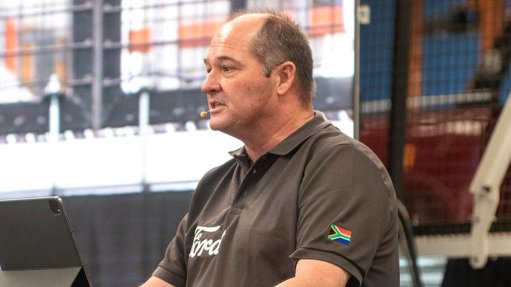
Neale Hill
Ford South Africa remains “actively engaged” with government and its rail arm Transnet to enable vehicle and component transport to and from the Gqeberha port, says Ford Motor Company Africa president Neale Hill.
“Frustratingly so we seem to make progress, and then it all seems to retreat.
“The development of the southern rail corridor has not kept pace with the commitments and promises we have made, and kept, in terms of investment and expansion.”
Ford started production of the new Ranger bakkie at its Silverton plant this week, following a R16-billion investment, without a clear view of when the southern rail corridor would be able to handle traffic from the Pretoria facility.
The plant has increased its capacity to 200 000 units a year, with production expected to reach 150 000 units next year, with around 70% of this volume to be exported.
Ford also has an engine plant in Gqeberha, with those engines destined for the export market, as well as the Silverton plant.
Ford would also like to ferry imported components and vehicles via the southern rail corridor.
Hill says almost 100% of Ford South Africa’s vehicles are currently moved by truck.
“Looking at our export numbers, we should have roughly 79 trucks a day [by 2025] on the road transporting cars to Durban if we don’t fix that corridor.”
Hill says it is of utmost importance to be able to use rail transport in order for Ford’s Pretoria plant to remain globally competitive in terms of logistics costs.
He believes that the volumes are sufficient to encourage Transnet to make the investment necessary in infrastructure and rolling stock, especially when considering that other vehicle manufacturers in Gauteng, such as BMW and Nissan, could also make use of a southern rail corridor.
Volkswagen and Isuzu, which are respectively based near and in Gqeberha, could also use the line to move cargo north.
Ford wants the southern rail line to run from Gauteng straight into the Gqeberha port, which would mean a limited number of vehicle handlings.
Should Ford export via Durban, the vehicles will be off-loaded at Cato Ridge and trucked to the port, which creates a situation where the vehicles are handled multiple times.
This generates the opportunity for possible damage to the vehicles.
“Also, as a country we cannot rely solely on one port – it is not strategically sound,” says Hill. “Relying on Durban only makes us very vulnerable as a country.”
He notes that the southern line will need to double in capacity to handle the vehicle volumes, while there is also a shortage of wagons to ferry vehicles.
“Transnet says it doesn’t have the capital to do that, but how do we then move the economy forward?
“It could be a private-public partnership,” he adds.
“The point is that we desperately need infrastructure expansion if we want this country to move forward.”
Hill says Ford has investigated moving its export units through the Maputo harbour in neighbouring Mozambique. However, the problem is that this facility is a dollar-based port, which could leave the car maker vulnerable to exchange rate fluctuations.